Art at Hillside
Vision:
Subject Leader: Mr Frost
Subject Support Coach: Miss D McCann
Link Governor: Jenny Craig
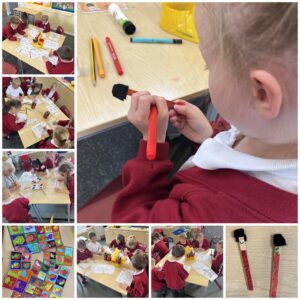 At Hillside, we believe that art is a vessel through which creativity, flair, emotions and personality can all be expressed and appreciated. We believe that the teaching of art should be through practical exploration where children can develop both an appreciation and a passion for a range of art forms, styles and medium. The cornerstone of our art education comes from children’s knowledge of artists, architects and sculptors. By allowing children to respond to the artist’s work that they are exposed to, we are creating independent learners who can make decisions for themselves based on what does or does not inspire them. We want our pupils to be confident in saying their opinions in a respectful and well-thought out manner and to recognise that opinions may vary greatly in art.
At Hillside, we believe that art is a vessel through which creativity, flair, emotions and personality can all be expressed and appreciated. We believe that the teaching of art should be through practical exploration where children can develop both an appreciation and a passion for a range of art forms, styles and medium. The cornerstone of our art education comes from children’s knowledge of artists, architects and sculptors. By allowing children to respond to the artist’s work that they are exposed to, we are creating independent learners who can make decisions for themselves based on what does or does not inspire them. We want our pupils to be confident in saying their opinions in a respectful and well-thought out manner and to recognise that opinions may vary greatly in art.
The Subject Leader:
I am Mr Frost, art subject leader at Hillside Primary School. Hillside’s motto is ‘Developing the Individual’, and I firmly believe that Art and Design contributes significantly to a pupil’s ‘rounded’ development. Art has the ability to be weaved throughout the curriculum and we do not underestimate its importance. Research suggests that the arts develop creativity, a core prerequisite of innovative mindsets, communicative attitudes and problem solving. Art and design embody some of the highest forms of human creativity. At Hillside, we have designed a high-quality art and design progressive plan that will engage, inspire and challenge pupils, equipping them with the knowledge and skills to experiment, invent and create their own works of art and design. As pupils progress, they should be able to think critically and develop a more rigorous understanding of art and design. In addition to this, our pupils will learn about how art has shaped our history and how it reflects it.
As our pupils progress through Hillside Primary School, they will draw upon their experiences within art and design, using a range of materials creatively to design and make products through drawing, painting and sculpture. They explore different techniques in using colour, pattern, texture, line, shape, form and space. A clear progressive pathway throughout the year groups (see progression map for more information) ensures that high standards and quality of teaching are maintained, resulting in our pupils making good progress in the skills that they are demonstrating, vocabulary that they are being exposed to and knowledge that they are gaining.
To ensure that high standards are being maintained across each year group, termly monitoring takes place in the form of evidence gathering from floor books (Key Stage One), sketch books (Key Stage Two) and pupil voice. When planning their topics, teachers focus on at least one artist per term. This meets the National Curriculum (2014) strand of knowing about great artists, craft makers and designers, and understanding the historical and cultural development of their art forms.
By the time our pupils reach the end of Key Stage Two, they will have been given opportunities to use a range of materials creatively to design and make products through drawing, painting and sculpture. They will have explored different techniques in using colour, pattern, texture, line, shape, form and space. In addition to this, our pupils will have learnt about the work of a range of artists, craft makers and designers; described the differences and similarities between different practices and disciplines; and made links to their own work. Our pupils will have created a wide range of art that will have been showcased within their classrooms, during assemblies and to other teachers within our school. This ensures that a sense of pride is created in terms of the output produced.
Our Curriculum and Curriculum Design
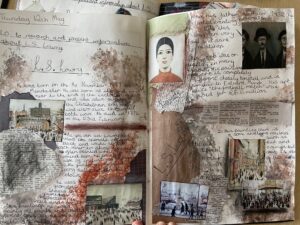 Art is closely linked to other subjects across the curriculum so that children get a holistic understanding of their unit. An example of this can be found in Year Two, where children look at the work of Martin Bulinya to supplement their learning of Africa; or in Year Six, where children study the work of William Morris alongside their topic of Victorians. By doing this, children are able to gain an appreciation for how art styles differ based on time period and locality.
Art is closely linked to other subjects across the curriculum so that children get a holistic understanding of their unit. An example of this can be found in Year Two, where children look at the work of Martin Bulinya to supplement their learning of Africa; or in Year Six, where children study the work of William Morris alongside their topic of Victorians. By doing this, children are able to gain an appreciation for how art styles differ based on time period and locality.
In EYFS art is seen as seminal in the achievement of the Early Learning Goals (ELGs). Whilst lessons are not focussed on these specific goals, they are focussed on the constituent skills required to attain them. Therefore, art lessons foster opportunities for children to: discuss art that they have seen and ask questions about it; give focused attention to what the teacher says and show an ability to follow instruction; be confident to try new activities and show independence; hold a pencil effectively; use a range of small tools, including scissors and paintbrushes; and begin to show accuracy and care when drawing. Art makes a significant contribution to expressing the world through activities such as discussing how art makes them feel, and from having hands on experiences with a range of media such as paint, colour and materials.
As pupils progress throughout the school, we want them to be more independent with their ideas and make appropriate choices for themselves. As such, we allow opportunities for the children to plan and design their ideas so they are clear on what their final piece will look like through the sequences of lessons that we teach. We encourage and praise the children to discuss their work and share why they have chosen a certain technique. Through utilisation of a variety of teaching and learning styles, pupils are motivated to question, form opinions and offer peer support as they focus on art from various periods of history including significant artists, architects, sculptors and painters from all around the world.
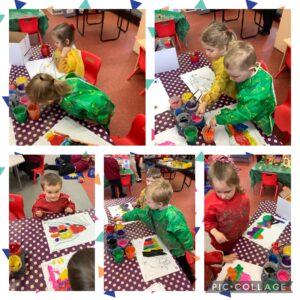 To this aim, we have designed our curriculum so that art units follow a six-lesson structure. The six lessons are carefully sequenced so that pupil’s skills and ideas are pruned before producing a final piece. An art unit will always start with a review of the artist of the term: children analyse the work of their artist, considering the era of the art and respond to different pieces by thinking about colours, line, form, shape or style. Lesson two, three and four include drawing from observation, working in the style of the artist and practising with the medium that they are focussing on for that half-term. Lesson five involves pupils creating a final piece, which brings together all of the skills from lesson one to four. The final lesson encourages pupils to think emotionally and critically about their own work as they self-assess their final-piece and express their opinions about their peers’ work in a respectful manner during an exhibition. This structure present both a clear journey for teachers to plan their artwork and allows children to build the necessary skills to produce a final art piece.
To this aim, we have designed our curriculum so that art units follow a six-lesson structure. The six lessons are carefully sequenced so that pupil’s skills and ideas are pruned before producing a final piece. An art unit will always start with a review of the artist of the term: children analyse the work of their artist, considering the era of the art and respond to different pieces by thinking about colours, line, form, shape or style. Lesson two, three and four include drawing from observation, working in the style of the artist and practising with the medium that they are focussing on for that half-term. Lesson five involves pupils creating a final piece, which brings together all of the skills from lesson one to four. The final lesson encourages pupils to think emotionally and critically about their own work as they self-assess their final-piece and express their opinions about their peers’ work in a respectful manner during an exhibition. This structure present both a clear journey for teachers to plan their artwork and allows children to build the necessary skills to produce a final art piece.
Each of these lessons is carefully aligned to the progression map, which demonstrates how expectations increase throughout the year groups. For example, children in year three are expected to imitate artwork that they see, whereas pupils in year four are expected to use the artwork that they see as inspiration for their own, personal final-piece. Progressively, in year six, pupils are expected to be able to make appropriate choices for themselves, like choosing an appropriate print type and using their own designs inspired by the artist they have studied. The increased opportunities for independence as children grow and develop ensures that by the time they leave primary school, children are able to use their learning to take charge of their own artwork and produce pieces more personal to themselves. This approach supports children’s transition to Key Stage 3, where they are expected to produce creative work through exploration of their own ideas and experiences.
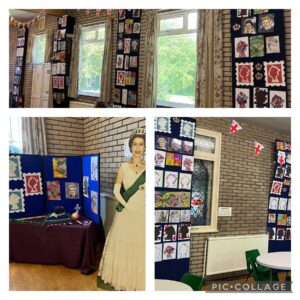
Art across the curriculum
At our school, we have aligned our curriculum so that the teaching of art is relevant to the history, geography or English units that children are studying at the time. English texts are chosen to engage and bring learning to life for the children, and from this we ensure that art is reinforced too. In ensuring that there is pride in their writing, some children are encouraged to design/ decorate their page so that it represents the writing they are doing; for example, in Year Six, when writing a persuasive leaflet about Alton Towers, children were encouraged to include their own drawings of the theme-park and colour the leaflet to represent the Alton Towers theme.
Mathematics/Science
The teaching of art contributes well to mathematics and science. Children develop the skill of accuracy when using rulers which they can then apply to their art lessons. This helps them to become aware of how they want their work to be presented. Knowledge of fractions and ratio is also important in art so that children can choose the correct proportions for different features; for example, knowing that a head is estimated to be about a seventh of the human form. Shape is a mathematical topic where children become familiarised with symmetry and pattern which they can use when creating their own art work. Particularly when studying artists such as Lowry and Warhol, geometric shapes are particularly prominent and these shapes are used to inspire children in their own artwork. Art also links well to skills needed in science lessons. Children learn how to create mathematical and scientific tables, such as bar charts, line graphs and even pie charts, to present their learning, which highlights the importance of accuracy.
Personal, Social, Health Education (PSHE)
Children develop self-confidence by having the opportunity to explain their designs and work in their art lessons. They are encouraged to offer peer support and praise to one another. In addition, children learn to express themselves and show their character through their own style of art as they progress through primary. Significant societal occasions, such as the Queen’s jubilee, Remembrance Day and Easter are just some events that we utilise at Hillside as art opportunities so that children can artistically express themselves with relevance to the things that are important to the society in which they live.
Computing
Computing enhances our teaching of art wherever appropriate in all key stages. The children use computers in a variety of ways such as finding information on the internet and presenting information on artists, architects, sculptors and painters via PowerPoint.
History/Geography
Art units are closely mapped-out with relevance to the historical or geographical topic being taught. These subjects work together to allow children to question art, and to research how famous artists, architects, sculptors and painters decided to pursue the subject; how their geographical upbringing has influenced their style; and how art has developed and been influenced by previous eras. Initial art lessons, within the 6-lesson structure, focus on children researching the work of famous artists, which allows them to understand the context behind the artwork. For example, it allows the children to understand what it would have been like during the period of the Maya and what equipment they had to use; how the locality and weather-types of Africa have impacted its art; and how events such as World War Two impact the style of artwork created by Henry Moore.
R.E
Throughout the year, there are many opportunities for art and R.E to link together. Hillside provides the children with R.E days during each term where children move through the school to learn about many religions. Children recognise that religious beliefs are often expressed through art forms, such as stained-glass windows, glyphs, marks and paintings. The children often work to create respectful, artistic pieces to depict religious content that is then showcased through the school. Linking these two subjects allows the children to develop a respect for different religions and to understand how art and religion link across the world.
British Values
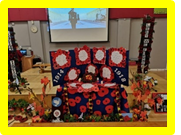
British Values is a core value that all staff share at Hillside Primary. British Values links with art in a variety of ways: children are encouraged to show mutual respect for others’ artwork and provide supportive feedback in exhibition lessons; and pupils are tolerant of other people’s opinions towards art work.
SMSC links
Spiritual
Art supports spiritual development by introducing children to the work of great artists. It also fosters awe and wonder at the achievements of these great works of art. Children develop great admiration, appreciation and respect for their peers’ work when they see the level of achievement, effort and progress. Furthermore, art is closely linked with R.E. topics, whereby children’s creativity is often encouraged in order to portray certain religious stories or other religious matter.
Moral
Art supports moral development by encouraging mutual respect and the consideration for others’ work. Pupils are encouraged to show compassion when assessing the work of others through, understanding how their comments can build up or hinder another’s self-belief. This is promoted through ‘exhibition’ lessons at the end of an art unit in which children assess their peers’ work, drawing on positives and areas for improvement. Children have to act sensitively to others, showing an awareness of how they can be a critical friend and offer constructive feedback without being offensive.
Social
Art and Design supports social development because, on occasion, children are required to work in pairs, groups or teams collaboratively. Children often work collaboratively requiring co-operation and communication, linking to the values of trust and compassion. Discussions about what the artist is trying to portray and their opinions on the artwork are actively encouraged, in an atmosphere whereby children mutually respect and value each other’s opinions. Children will also work with each other to discuss and analyse the art work of their termly artists.
Cultural
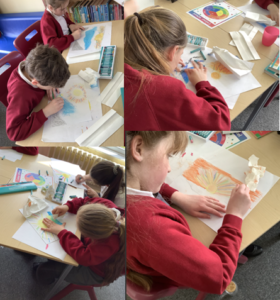 Art supports cultural development work by enabling children to study art involving various cultures and civilizations from around the world. They lead to a greater understanding of different ways of life and a respect for cultures that are very different from our own; how they can enrich our own lives. The fusion of art work between our own and other cultures leads to pupils incorporating designs, patterns and motifs in their own work developed by a deeper understanding of the culture. In addition, the art long-term plan, is designed to link closely with the curriculum areas with which they are best suited. For example, in Year Two, to support the learning of the overarching unit ‘Africa’, the artwork and style of the Maassai people is studied. For the overarching Year Six unit, ‘The Victorians’, the work of designer William Morris is studied and children work up to creating a motif. Furthermore, this artwork is supplemented more during their trip to Blists Hill where they look at an alternative method of printing known as Intaglio Printing. Local artwork is considered during a ‘Local Area Study’ in which children go to Gladstone Pottery museum to make ceramics.
Art supports cultural development work by enabling children to study art involving various cultures and civilizations from around the world. They lead to a greater understanding of different ways of life and a respect for cultures that are very different from our own; how they can enrich our own lives. The fusion of art work between our own and other cultures leads to pupils incorporating designs, patterns and motifs in their own work developed by a deeper understanding of the culture. In addition, the art long-term plan, is designed to link closely with the curriculum areas with which they are best suited. For example, in Year Two, to support the learning of the overarching unit ‘Africa’, the artwork and style of the Maassai people is studied. For the overarching Year Six unit, ‘The Victorians’, the work of designer William Morris is studied and children work up to creating a motif. Furthermore, this artwork is supplemented more during their trip to Blists Hill where they look at an alternative method of printing known as Intaglio Printing. Local artwork is considered during a ‘Local Area Study’ in which children go to Gladstone Pottery museum to make ceramics.
Educational visits
We place great importance on enrichment opportunities to enhance the art curriculum. Opportunities allow teachers to facilitate learning so that pupils can note connections, contrasts and trends over time and are more holistically developed to enter the world as wider informed individuals. Enrichment opportunities include:
- Year One received a visit from members of The Brampton Museum, who delivered an outreach programme where children looked at old toys to inspire their art unit, made pomanders Christmas tree decorations.
- Year Two visited Gladstone Pottery museum to look at how Stoke-on-Trent was revolutionised by the pottery industry and the impact that it had on art designs.
- Year Three visited Outback2Basics where they looked at stone-age art.
- In Year Four took part in a Roman Day, where they created Roman Jewellery.
- Year Six visited Blists Hill where they planned, designed and created an intaglio print.
- In the autumn term, children took part in an art after-school club where they created a piece of artwork inspired by Stoke-on-Trent
- For the Queen’s jubilee, children each created a piece of artwork focussed on the queen. The artwork was then displayed on the day of the jubilee at the local church, where children and parents could go to see their artwork in an exhibition.
Assessment for learning
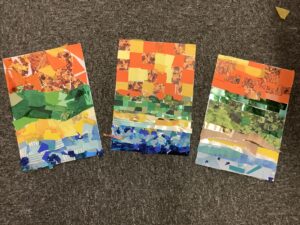 Children demonstrate their ability in art in a variety of different ways through a range of medium. The medium mentioned explicitly in the national curriculum are explored multiple times as a child progresses through primary. This ensures that skills are built upon and developed each time. At the end of an art unit, teachers assess the pupil against the progression map, deciding whether the pupil is emerging, expected, or exceeding the standard. This is recorded on an online assessment system which can be accessed by staff across the school. This is used to provide accurate information to other teachers, the art subject leader and learning support assistants termly and during times of transition.
Children demonstrate their ability in art in a variety of different ways through a range of medium. The medium mentioned explicitly in the national curriculum are explored multiple times as a child progresses through primary. This ensures that skills are built upon and developed each time. At the end of an art unit, teachers assess the pupil against the progression map, deciding whether the pupil is emerging, expected, or exceeding the standard. This is recorded on an online assessment system which can be accessed by staff across the school. This is used to provide accurate information to other teachers, the art subject leader and learning support assistants termly and during times of transition.
Assessment does not just take place at the end of a unit, however. Assessment is ingrained into all art lessons, with children constantly prompted to self-assess their own work and comment on what worked well/ didn’t work well. When a pupil produces a final piece, that work is then presented in an exhibition, where their peers comment on what is good about the piece and what could be improved in a constructive, friendly manner. The teacher is consistently assessing children as they walk around the class, identifying any issues and intervening when necessary.
Growth Mindset
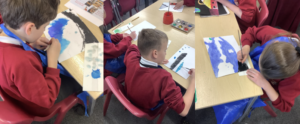 I believe that all pupils are able to make good progress in art. It is very common to hear children say, ‘I aren’t very good at art’. At Hillside we aim to foster a ‘can do’ attitude, which encourage children to make mistakes in work and put in effort with the knowledge that every blank page is an opportunity to improve from their last piece of work. We encourage the children to change their mindset and think positively about art. The children have been taught to believe that art is not something that is fixed, but rather can be improved on, regardless of attainment level. So, instead of saying ‘I can’t do it!’ the children follow the sentence with ‘yet!’ Children know that once they have practised all of the skills in the build up to final piece, they will make progress and improve.
I believe that all pupils are able to make good progress in art. It is very common to hear children say, ‘I aren’t very good at art’. At Hillside we aim to foster a ‘can do’ attitude, which encourage children to make mistakes in work and put in effort with the knowledge that every blank page is an opportunity to improve from their last piece of work. We encourage the children to change their mindset and think positively about art. The children have been taught to believe that art is not something that is fixed, but rather can be improved on, regardless of attainment level. So, instead of saying ‘I can’t do it!’ the children follow the sentence with ‘yet!’ Children know that once they have practised all of the skills in the build up to final piece, they will make progress and improve.
Careers
Pupil Voice
“Art is my favourite subject because I like painting,” Year One pupil.
“I enjoyed the art work about Africa. I like the colour that Martin Bulinya uses in his work,” Year Two pupil.
“I liked drawing the different animals in the rainforest,” Year Three pupil.
“I really like Andy Warhol’s prints and when we did a press-print of them,” Year Four pupil.
“Edward Munch is my favourite artist. His painting called ‘The Scream’ is really good and I enjoyed working in a similar style to him,” Year Five pupil.
“I love art, it’s my favourite subject. I like how we get to use and experiment with different medium. I like using pencil the most because I like shading but I also liked when we did the mono-prints with William Morris,” Year Six pupil.
“I really liked doing the jubilee art work. I went to the church to look at it over the holidays with my mum and dad,” Year Three pupil.
